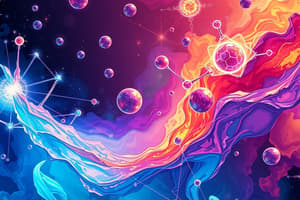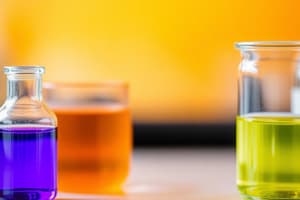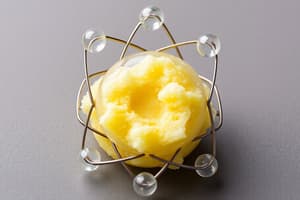Podcast
Questions and Answers
What is chemistry?
What is chemistry?
Study of matter
What does mass refer to?
What does mass refer to?
Amount of matter present in the material
How is weight calculated?
How is weight calculated?
Weight = Mass x Pull of gravity
Which of the following is the simplest form of matter?
Which of the following is the simplest form of matter?
What is a compound?
What is a compound?
What is the units of measurement for mass?
What is the units of measurement for mass?
Plasma is a colorless fluid part of blood.
Plasma is a colorless fluid part of blood.
What is serum?
What is serum?
A mixture composed of 2 or more substances that are not chemically combined is called a ______.
A mixture composed of 2 or more substances that are not chemically combined is called a ______.
Match the classification of mixtures with their definitions:
Match the classification of mixtures with their definitions:
Which of the following is NOT a method for separating components of mixtures?
Which of the following is NOT a method for separating components of mixtures?
What is an intrinsic property of matter?
What is an intrinsic property of matter?
Which of the following is a sign of a chemical change?
Which of the following is a sign of a chemical change?
What is the law of conservation of mass?
What is the law of conservation of mass?
Who proposed the atomic theory that states all atoms of a given element are alike?
Who proposed the atomic theory that states all atoms of a given element are alike?
What is an allotrope?
What is an allotrope?
Study Notes
Chemistry Overview
- Chemistry is the study of matter, involving its composition, structure, and changes, along with the energy involved in these changes.
- Matter is defined as anything that occupies space and possesses mass.
Key Definitions
- Mass indicates the amount of matter in an object.
- Weight is the product of mass and gravitational pull.
Classification of Matter
- Element: The simplest form of matter consisting of one type of atom.
- Compound: A substance formed by two or more elements chemically combined in a definite ratio.
- Mixture: A combination of two or more substances not chemically united.
Units of Measurement
- Length: Meter (m)
- Mass: Kilogram (kg)
- Time: Seconds (sec)
- Temperature: Kelvin (K)
Biological Fluids
- Plasma: The colorless fluid in blood that transports cells and nutrients.
- Serum: The yellowish liquid that separates from blood upon coagulation, rich in proteins and used for immunity and diagnostics.
Classification of Mixtures
- Based on particle nature:
- Homogenous Mixture: Uniform composition throughout.
- Heterogenous Mixture: Composition varies in different parts.
- Based on particle size:
- Solution: Uniform mixture (solute dissolved in solvent).
- Suspension: Coarse mixture of insoluble solid in liquid.
- Colloid: Intermediate state where particles are small but not fully dissolved.
Separation Processes
- Decantation: Based on density differences.
- Distillation: Separation by evaporation and condensation.
- Evaporation: Removal of liquid to isolate solids.
- Magnetic Separation: Using magnets to separate magnetic materials.
- Filtration: Separating solids from liquids using a barrier.
- Sorting: Manual separation by observation.
- Centrifugation: Utilizing centrifugal force for separation.
- Fractional Crystallization: Crystallizing components at different temperatures.
- Chromatography: Separation based on differences in solvent affinity.
Properties of Matter
- Intrinsic/Intensive Properties: Independent of mass (e.g., density, melting point).
- Extrinsic/Extensive Properties: Dependent on mass (e.g., weight, volume).
Changes in Matter
- Physical Change: Change in state (e.g., solid to liquid).
- Chemical Change: Alters both intrinsic and extrinsic properties.
Evidence of Chemical Change
- Gas evolution, precipitate formation, light emission, heat absorption or generation, and electrical generation.
Types of Chemical Reactions
- Direct Union: Reactants combine to form a compound.
- Decomposition: A compound breaks down into simpler substances.
- Single Replacement: One element replaces another in a compound.
- Double Displacement: Exchange of components between two compounds.
Chemical Change Processes
- Oxidation: Loss of electrons or gain of oxygen.
- Reduction: Gain of electrons or loss of oxygen.
- Neutralization: Reaction between acid and base resulting in salt and water.
- Hydrolysis: Reaction of water with a substance.
- Saponification: Reaction of base with fats to produce soap.
- Fermentation: Conversion of organic substances into alcohol by microbes.
Nuclear Change
- Changes within the nucleus involving:
- Nuclear Fission: Splitting of heavy atomic nuclei.
- Nuclear Fusion: Combining of light atomic nuclei.
Historical Models of the Atom
- Democritus: Proposed matter consists of indivisible particles, naming them "atomos."
- John Dalton: Introduced the "Billiard Ball Model"; outlined atomic theory regarding element similarities and combinations.
- J.J. Thompson: Proposed "Raisin Bread" model; discovered electrons.
- Ernest Rutherford: Identified the proton; suggested atoms are mostly empty space via the Gold Foil Experiment.
- Niels Bohr: Created the planetary model of the atom.
- Erwin Schrödinger: Developed the quantum mechanical model; introduced the concept of electron clouds.
- James Chadwick: Discovered the neutron.
Atomic Definitions
- Ion: A charged atom.
- Atomic Number: Indicates the number of protons.
- Mass Number: Sum of protons and neutrons.
Allotropism
- Allotropes: Different structural forms of the same element.
- Examples include diamond and graphite for carbon and three forms of oxygen: nascent (O), molecular (O2), and ozone (O3).
Quantum Principles in Electron Configuration
- Pauli’s Exclusion Principle: No two electrons can occupy the same quantum state; each orbital holds a maximum of 2 electrons.
- Heisenberg Uncertainty Principle (incomplete context provided).
Laws of Chemistry
- Law of Conservation of Mass: Mass remains constant in a closed system during a reaction.
- Law of Definite Proportions: Compounds consist of elements in specific mass ratios.
- Law of Multiple Proportions: Elements combine in ratios of small whole numbers to form different compounds.
Studying That Suits You
Use AI to generate personalized quizzes and flashcards to suit your learning preferences.
Description
This quiz covers the fundamental concepts of chemistry, including the definition of matter, key classifications of substances, units of measurement, and biological fluids. Test your understanding of elements, compounds, and mixtures, as well as essential terms related to mass and weight.




